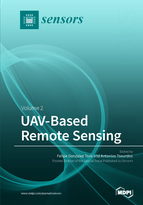UAV-Based Remote Sensing
A special issue of Sensors (ISSN 1424-8220). This special issue belongs to the section "Remote Sensors".
Deadline for manuscript submissions: closed (31 December 2016) | Viewed by 346750
Special Issue Editors
Interests: remote sensing; UAV; unmanned aerial systems (UAS); bioinspired optimisation; multidisciplinary design optimisation; optimisation; drones; wildlife monitoring; precision agriculture
Special Issues, Collections and Topics in MDPI journals
Interests: unmanned aircraft systems; decision making on multi-agent systems; data-centric guidance and control; swarm
Special Issues, Collections and Topics in MDPI journals
Special Issue Information
Dear Colleagues,
There have been active developments and growth in Unmanned Aerial Vehicle (UAV) platforms, sensors, and image processing which have resulted in an increasing uptake of this technology in aerial robotics as well as the environmental and remote sensing science community. Even though tough regulations across the globe may still limit the broader use of UAVs for some applications, technological development in both UAV platforms, sensor miniaturisation, and robotic sensing is progressing rapidly. The design of novel UAV systems and the use of UAV platforms integrated with RGB, multispectral, hyperspectral, thermal imaging, gas sensing and or laser scanning sensors have now been demonstrated in both research and practical applications.
Novel UAV platforms, UAV-based sensors, robotic sensing and imaging techniques, the development of processing workflows, as well as the capacity of ultra-high temporal and spatial resolution data, provide both opportunities and challenges that will allow engineers and scientists to address novel and important scientific questions in UAV and sensor design, remote sensing and environmental monitoring.
This Special Issue focuses on UAV-Based Remote Sensing.
The scope of this issue includes, but is not limited to UAV sensor design, improvements in UAV sensor technology, descriptions of processing algorithms as well as the interpretation of spatio-temporal geological, forestry, agricultural, biosecurity, ecological, reef, and atmospheric dynamics using time series.
Prospective authors are invited to contribute to this Special Issue of Sensors (Impact Factor: 2.245 (2014); 5-Year Impact Factor: 2.474 (2014) by submitting an original manuscript.
Contributions may focus on, but are not limited to:
- UAV-based: stereo imaging, structure from motion (SfM) imaging, laser scanning, multispectral imaging, hyperspectral imaging and thermal imaging.
- UAV-based change detection
- Methodological developments for information extraction from UAV-based data: e., automatic feature extraction, vegetation indices development
- Real-time georeferencing for UAV-based imaging
- Radiometric and spectral calibration of UAV-based sensors
- Optical, multi-spectral, hyperspectral, laser, and optical SAR technologies
- Artificial intelligence and data mining based strategies from UAVs
- UAV onboard data storage, transmission, and retrieval
- Collaborative strategies and mechanisms to control multiple UAVs and sensor networks for the purpose of remote sensing
- UAV sensor applications: precision agriculture, spatial ecology, pest detection, reef, forestry, volcanology, wildlife species tracking, search and rescue, target tracking, the monitoring of the atmosphere, chemical, biological, and natural disaster phenomena, fire prevention, flood prevention, volcanic monitoring, pollution monitoring, micro-climates and land use.
Dr. Felipe Gonzalez Toro
Guest Editor
Prof. Dr. Antonios Tsourdos
Co-Guest Editor
Manuscript Submission Information
Manuscripts should be submitted online at www.mdpi.com by registering and logging in to this website. Once you are registered, click here to go to the submission form. Manuscripts can be submitted until the deadline. All submissions that pass pre-check are peer-reviewed. Accepted papers will be published continuously in the journal (as soon as accepted) and will be listed together on the special issue website. Research articles, review articles as well as short communications are invited. For planned papers, a title and short abstract (about 100 words) can be sent to the Editorial Office for announcement on this website.
Submitted manuscripts should not have been published previously, nor be under consideration for publication elsewhere (except conference proceedings papers). All manuscripts are thoroughly refereed through a single-blind peer-review process. A guide for authors and other relevant information for submission of manuscripts is available on the Instructions for Authors page. Sensors is an international peer-reviewed open access semimonthly journal published by MDPI.
Please visit the Instructions for Authors page before submitting a manuscript. The Article Processing Charge (APC) for publication in this open access journal is 2600 CHF (Swiss Francs). Submitted papers should be well formatted and use good English. Authors may use MDPI's English editing service prior to publication or during author revisions.








